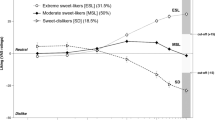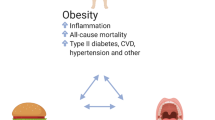Abstract
Objective: To characterize taste preferences in habitual high fat (HF) and low fat (LF) phenotypes.
Design: Eighteen test solutions to taste for each subject group in a fully repeated 2×6×3 measures design.
Setting: The Human Appetite Research Unit at Leeds University, Psychology Department.
Subjects: Eight lean HF (mean percentage fat intake 43.4% daily energy) and eight lean LF (mean percentage fat intake 32.7% daily energy) were recruited from the staff/student population of Leeds University.
Interventions: All subjects were required to taste 18 solutions based on six levels of fat content and three levels of sucrose content. Subjects rated each solution for fat content, sweetness and pleasantness.
Results: HF and LF showed significant effect for the fat content of the solution on the perception of creaminess (P<0.000), and sugar content on the perception of sweetness (P<0.000). HF and LF did not differ in their taste preferences and no preferred level of fat or sweetness was detected in either group.
Conclusions: In young adult males, habitual food selection is not related to taste preference.
Sponsorship: This study was supported by the Biotechnology and Biological Sciences Research Council (BBSRC).
European Journal of Clinical Nutrition (2001) 55, 1016–1021
This is a preview of subscription content, access via your institution
Access options
Subscribe to this journal
Receive 12 print issues and online access
$259.00 per year
only $21.58 per issue
Buy this article
- Purchase on Springer Link
- Instant access to full article PDF
Prices may be subject to local taxes which are calculated during checkout
Similar content being viewed by others
References
Blundell JE & Cooling J (1999) The high-fat and low-fat phenotype: food preferences are not related to taste preferences Int. J. Obes. Relat. Metab. Disord. 23 (Suppl 5), S4 6
Blundell JE & Macdiarmid JI (1997) Fat as a risk factor for overconsumption: satiation, satiety, and patterns of eating J. Am. Diet. Assoc. 97(Suppl) S63–S69
Cooling JR & Blundell JE (1998a) Are high-fat and low-fat consumers distinct phenotypes? Differences in the subjective and behavioural response to energy and nutrient challenges Eur. J. Clin. Nutr. 52 193–201
Cooling JR & Blundell JE (1998b) Differences in energy expenditure and substrate oxidation between habitual high fat and low fat consumers (phenotypes) Int. J. Obes. Relat. Metab. Disord. 22 612–618
Cooling JR, Barth J & Blundell JE (1998) The high-fat phenotype: Is leptin involved in the adaptive response to a high fat (high energy) diet? Int. J. Obes. Relat. Metab. Disord. 22 1132–1135
de Graaf C (1993) The validity of appetite ratings Appetite 21 156–160
Drewnowski A (1997) Taste preferences and food intake A. Rev. Nutr. 17 237–253
Drewnowski A, Brunzel JD, Sande K, Iverius P & Greenwood MRC (1985) Sweet tooth reconsidered: Taste responsiveness in human obesity Physiol. Behav. 35 617–622
Drewnowski A & Greenwood MRC (1983) Cream and sugar: human preferences for high-fat foods Physiology and Behaviour 30 629–633
Drewnowski A, Shrager EE, Lipsky C, Stellar E & Greenwood MRC (1989) Sugar and fat: sensory and hedonic evaluation of liquid and solid foods Physiol. Behav. 45 177–183
Drewnowski A, Kurth C, Holden-Wiltse J & Saari J (1992) Food preferences in human obesity: carbohydrates versus fats Appetite 18 207–221
Golay A & Bobbioni E (1997) The role of dietary fat in obesity Int. J. Obes. Relat. Metab. Disord. 21(Suppl 3) S2–S11
Green PR, Bowden DJ, Kestin M & Feng Z (1993) Influences on food selection of women on high- and low-fat diets J. Appl. Biobehav. Res. 1 174–198
Hill AJ, Rogers PJ & Blundell JE (1995) Techniques for the experimental measurement of human eating behaviour and food intake: a practical guide Int. J. Obes. Relat. Metab. Disord. 19 361–375
Hill JO & Prentice AM (1995) Sugar and body weight regulation Am. J. Clin. Nutr. 52(Suppl) 264S–274S
Lissner L & Heitmann BL (1995) Dietary fat and obesity: evidence from epidemiology Eur. J. Clin. Nutr. 49 79–90
Macdiarmid JI, Hamilton KV & Blundell JE (1995) Leeds High Fat Study: comparison of food choice and dietary patterns in high and low fat consumers Appetite 24 29 3
Margetts BM, Cade JE & Osmond C (1989) Comparison of a food frequency questionnaire with a diet record Int. J. Epidemiol. 18 868–873
Mattes RD (1993) Fat preference and adherence to a reduced-fat diet Am. J. Clin. Nutr. 57 373–381
Mela DJ & Sacchetti DA (1991) Sensory preference for fats: relationship with diet and body composition Am. J. Clin. Nutr. 53 908–915
Warwick ZS & Schiffman SS (1992) Role of dietary fat in calorie intake and weight gain Neurosci. Biobehav. Rev. 16 585–596
Author information
Authors and Affiliations
Corresponding author
Rights and permissions
About this article
Cite this article
Cooling, J., Blundell, J. High-fat and low-fat phenotypes: habitual eating of high- and low-fat foods not related to taste preference for fat. Eur J Clin Nutr 55, 1016–1021 (2001). https://doi.org/10.1038/sj.ejcn.1601262
Received:
Revised:
Accepted:
Published:
Issue Date:
DOI: https://doi.org/10.1038/sj.ejcn.1601262
Keywords
This article is cited by
-
Taste preferences in association with dietary habits and weight status in European children: results from the IDEFICS study
International Journal of Obesity (2012)
-
Is Dietary Fat Intake Related to Liking or Household Availability of High‐ and Low‐Fat Foods?
Obesity Research (2004)
-
Fat is not a hedonist issue
Nature (2001)



